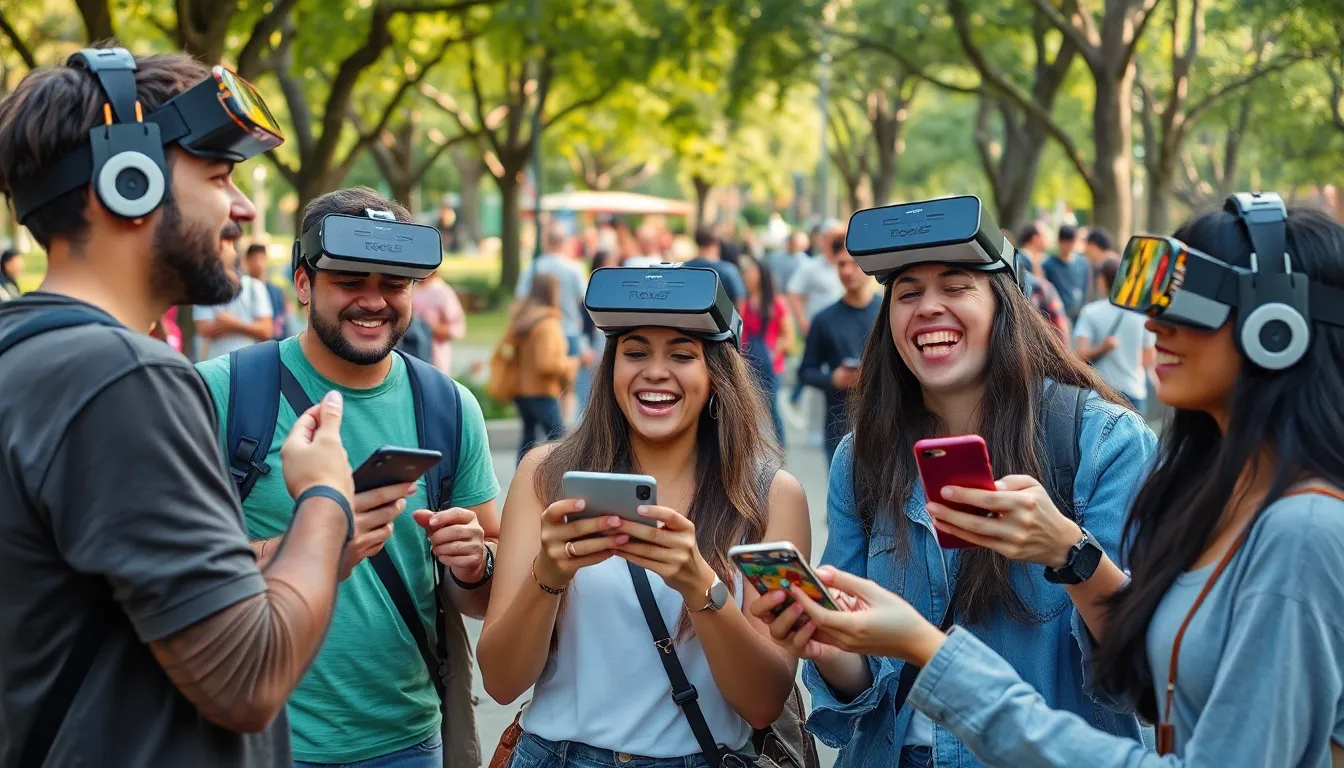Imagine stepping into a world where your living room transforms into a battlefield or your local park becomes a treasure trove of mythical creatures. Augmented reality games are doing just that, blending the digital realm with reality in ways that make even the most mundane chores feel like an epic quest. Who knew that picking up groceries could lead to a dragon-slaying adventure?
Table of Contents
ToggleOverview of Augmented Reality Games
Augmented reality games merge digital content with the physical world, creating a unique gaming experience. These games utilize smartphones, tablets, or AR glasses to superimpose graphics onto real-life environments. Environments become interactive spaces where players can engage with virtual characters or objects.
Notable examples include “Pokémon GO” and “Harry Potter: Wizards Unite.” Players find and capture Pokémon in their neighborhoods or cast spells in familiar settings. In these games, users explore their surroundings while interacting with the digital universe.
The technology relies on GPS, cameras, and sensors to pinpoint a player’s location and accurately place virtual elements. Additionally, advancements in AR technology enhance realism and user engagement. High-quality graphics and responsive interactivity contribute to a more immersive experience.
According to industry reports, the augmented reality gaming market is expected to reach $300 billion by 2025. This growth highlights increasing consumer interest and the potential for innovation in the gaming sector. Increased collaboration between tech companies and game developers fosters the emergence of new AR titles.
User engagement often increases when games blend physical activity with digital play. The appeal lies in the ability to create social experiences by allowing players to connect in real time. Events and challenges promote community interaction while enhancing gameplay.
In essence, augmented reality games transform the way individuals interact with both their immediate surroundings and the broader digital landscape. These games challenge traditional notions of gaming by integrating the virtual and real worlds in compelling ways.
Popular Augmented Reality Games

Augmented reality games captivate players by merging digital elements with real-world settings. Several standout titles illustrate this trend effectively.
Game 1: Overview and Features
“Pokémon GO” remains one of the most recognized AR games, captivating millions since its 2016 launch. Players capture virtual Pokémon by exploring their neighborhoods. The game employs GPS to position Pokémon in real locations. Regular events and challenges keep engagement high. Players often participate in community days, where they can catch rare Pokémon and join others in real-time battles. Such dynamic elements ensure a lively gaming experience, blending excitement with exercise.
Game 2: Overview and Features
“Harry Potter: Wizards Unite” offers an immersive experience for fans of the Wizarding World. Launched in 2019, this game invites players to uncover magical artifacts dispersed across their communities. Utilizing AR technology, players encounter iconic creatures and spells based on the series. Encounters with fellow wizards and challenges add a social dimension, encouraging collaboration. Events often coincide with real-world locations, enhancing the thematic connection. Vibrant graphics and interactive quests elevate player engagement significantly.
Game 3: Overview and Features
“Ingress” was one of the pioneers of AR gaming, debuting in 2013. This game introduces players to a faction-based narrative involving science fiction and strategy. Participants claim “portals” located at real landmarks, which enhances engagement with local history and culture. Players strategize and collaborate with teammates to maintain control over territory. Frequent community events further foster player interaction. The game’s strategic depth and emphasis on teamwork create a compelling reason to explore one’s surroundings.
Benefits of Augmented Reality Games
Augmented reality games provide numerous advantages that enhance the gaming experience significantly.
Enhanced Engagement
Players experience heightened levels of immersion through augmented reality games. These games blend interactive elements with the real world, captivating users in a way that traditional gaming cannot. For instance, collecting items or completing quests requires players to explore their surroundings, making the experience physically engaging. Enhanced graphics and sound effects also serve to create a more realistic atmosphere. As players become invested in the gameplay, the likelihood of them returning to the game increases. This trend is evident in titles such as “Pokémon GO,” which has maintained a dedicated player base since its release in 2016. Regular updates and community events keep the content fresh, strengthening overall user engagement further.
Social Interaction
Social interaction flourishes in augmented reality games. Players often collaborate in real-time, connecting with friends and meeting new people. Many AR titles encourage teamwork, promoting camaraderie as users work together to complete challenges. Engagement opportunities arise through events and competitions that foster community involvement, such as those hosted in “Harry Potter: Wizards Unite.” Players from different backgrounds share their experiences, forming friendships through shared activities. Another example is “Ingress,” where players strategize and claim real-world locations as part of competing teams. This sense of belonging enhances social networks, turning gaming into a social event rather than a solitary endeavor.
Challenges in Augmented Reality Games
Augmented reality games face multiple challenges that can hinder player enjoyment and engagement.
Technical Limitations
Technical limitations often impact the performance of AR games. Device compatibility poses a significant issue; not all smartphones and tablets support the necessary hardware. This results in reduced accessibility for potential players. Additionally, GPS accuracy can vary, causing frustration when games fail to accurately position virtual elements. Network connectivity affects gameplay as well; inconsistent internet can disrupt experiences. Battery drain remains a persistent concern, as heavy usage of GPS and augmented features consumes device power rapidly. These limitations illustrate the importance of ongoing advancements in technology to enhance AR game experiences.
User Experience Issues
User experience issues can significantly detract from AR gaming enjoyment. Overwhelming immersive features may lead to sensory overload for some players. Many titles require users to navigate outdoor environments, which can pose safety concerns if players are distracted by the game. Furthermore, the learning curve can be steep for new users unfamiliar with the technology. Social dynamics also affect user experience; players may feel isolated if local engagement is low. Addressing these factors is crucial for developers aiming to create engaging and inclusive AR gaming experiences.
Future Trends in Augmented Reality Games
Emerging technologies are set to redefine augmented reality games. Innovations in artificial intelligence will allow for more immersive and adaptive gaming experiences. Enhanced computer vision enables AR games to recognize surroundings better, improving interaction with the environment.
Broader use of 5G networks supports seamless connectivity, reducing lag and enhancing real-time interactions. Increased battery efficiency in mobile devices allows for longer gameplay sessions without interruptions. This evolution sets the stage for user-generated content, enabling players to create and share their custom experiences.
AR games will likely incorporate mixed reality elements, blending the digital and physical worlds even more convincingly. Customization options will grow, catering to individual preferences and empowering players to shape their gameplay. As a result, community-driven features may become more prominent, fostering collaboration and social engagement.
In terms of monetization, subscription models and microtransactions will likely gain traction, offering players new ways to support their favorite games. Data analytics will play a critical role in understanding player behavior, thus helping developers tailor experiences to audience preferences. This insight can create more personalized content, enhancing overall satisfaction.
Increased collaboration among tech companies will lead to the development of more robust AR platforms. Partnerships between gaming studios and educational institutions may emerge, highlighting AR’s potential as a learning tool. The growing interest in AR technology spans various sectors, indicating bright prospects for augmented reality games in the entertainment landscape.
With projected market growth to $300 billion by 2025, augmented reality games are poised to captivate an even larger audience. As creativity and technology converge, the future of augmented reality games appears boundless, offering countless possibilities for innovation and engagement.
Augmented reality games are redefining the gaming landscape by blending digital experiences with the physical world. As technology evolves players can expect more immersive and interactive gameplay that encourages social connections and community engagement. The rapid growth of the AR gaming market highlights the increasing interest and innovation within this space.
With advancements in technology and the potential for user-generated content the future of augmented reality gaming promises to be exciting. As developers address current challenges and leverage new technologies the possibilities for AR games will continue to expand. This evolution not only enhances player experiences but also transforms how individuals engage with their environments.






